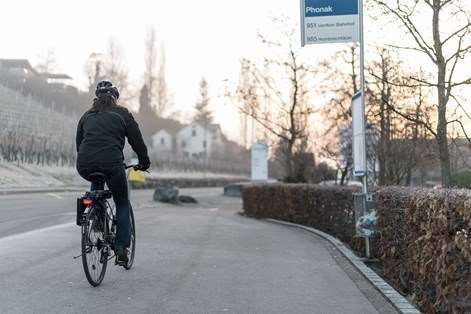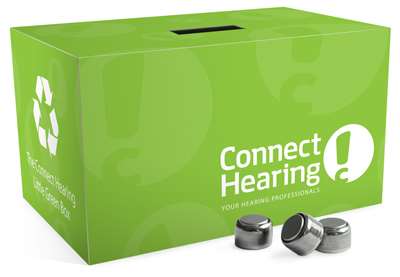Commitments
Safeguarding the environment
Environmentally friendly practices
Sonova makes an explicit commitment to continuously promote and pursue environmentally friendly practices throughout the entire lifecycle of its products and across all its business activities. We set the priorities and provide the resources needed to reduce our environmental impact through responsible, efficient management of our buildings and infrastructure, processes, products, and services. The environmental policy supports Sonova’s commitment to behave proactively and describes the company’s environmental performance management organization and responsibilities, along with their relevant environmental aspects and other management approaches.
Sonova’s environmental program sets clearly defined targets, of which the three most important are: a 10% reduction from 2013/14 levels of production-related carbon emissions intensity by 2018/19, a 10% reduction from 2013/14 levels of air travel-related carbon emissions intensity by 2018/19, and ensuring that 100% of purchase volume comes from suppliers having environmental friendly practices in place by 2018/19. We continuously monitor and optimize environmental objectives and performance across the Group.
As part of this continuous improvement in operations, Sonova has committed to establish ISO 14001-certified environmental management systems at all its key manufacturing and distribution centers; these require employees to make sound environmental decisions when designing, manufacturing, and servicing products. For non-manufacturing sites, Sonova has implemented an adapted environmental management system to ensure integration of environmental factors in decision-making and improvement in environmental performance. The following Sonova facilities are currently certified to the ISO 14001 standard: Sonova AG and Advanced Bionics AG (Stäfa, Switzerland), Phonak Communications AG (Murten, Switzerland), Advanced Bionics LLC (Valencia, USA), Phonak Operation Center Vietnam Co., Ltd (Binh Duong, Vietnam), Unitron Hearing (Suzhou) Co., Ltd (Suzhou, China), Phonak LLC manufacturing and distribution centers in Warrenville/ Aurora (USA).
We insist on environmentally friendly business practices throughout our supply chain: we do not restrict our environmental standards to our own operations, but consider them equally crucial in selecting our suppliers. The Sonova Group Supplier Principles recommend that suppliers use the international ISO 14001 standard as the starting point and basis for their work. In 2017, 95.5% of purchase volume came from suppliers having environmental friendly practices in place. This assessment was made based on internal or external audits.
Thanks to Sonova’s low risk exposure to environmental issues and its strict group-wide environmental management, no fines or non-monetary sanctions were levied against Sonova in 2017 (or in previous years) for noncompliance with environmental laws or regulations.
Climate protection and energy reduction
Climate change is one of the biggest challenges of our time: it requires prompt, effective action from governments, industries, and individuals. Sonova is committed to reducing the carbon footprint attributable to its direct and indirect energy consumption, including energy used in transportation and distribution. The company’s strategy requires a steady increase in the energy efficiency of its operations, integrating environmentally friendly energy purchase and generation, and optimizing transportation and distribution logistics. Sonova has set up implementation initiatives that concentrate on its most energy-intensive facilities, while considering other sites that show realistic potential for improvement. From a risk perspective, Sonova’s business has a low exposure to climate change and hence anticipates no financial implications for the organization’s activities from this source.
In 2017, the total energy consumption of the Sonova Group amounted to 97,890 megawatt-hours (MWh). 42,276 MWh can be attributed to the wholesale business and 55,614 MWh to the retail business. The wholesale business accounts for a higher proportion of electricity consumption because of air conditioning systems in operation centers in China, Vietnam and the US. On the other hand, the retail business accounts for a higher proportion of heating because of a stronger retail presence in Europe, where cold winters make heating more relevant. A total of 5,520 MWh of electricity consumption stems from renewable energy sources.
As a result of the acquisition of AudioNova, the retail business was included in the 2017/18 reporting for the first time. The values for the retail business are based on extrapolations and not actual data. Due to additional changes in the reporting scope, the values are not comparable to the previous years.
Energy consumption
|
In MWh |
|
|
|
|
|
|
|
|
|
|
|
2017 |
|
2016 |
|
2015 |
|
|
|
Retail 1 |
Wholesale |
|
Wholesale |
|
Wholesale |
|
Heating |
|
36,926 |
7,812 |
|
8,033 |
|
8,195 |
|
Electricity |
|
18,688 |
34,465 |
|
30,629 |
|
28,892 |
|
Total |
|
55,614 |
42,276 |
|
38,661 |
|
37,087 |
1 extrapolation, no actual data
Restatement
The energy and carbon emissions values published in the CSR Report 2016/17 for Scope 1 and 2 were restated for the year 2015 and 2016 due to data quality improvements and changes in the data collection methodology.
Sonova Group’s absolute carbon footprint of Scope 1 and 2 emissions amounts to 38,701 metric tons of CO2 equivalents (t CO2eq). The figure is not comparable to those of previous years because of changes in emission factors and reporting scope. The emissions values for the retail business are based on extrapolations and not actual data.
In 2017, we estimated Scope 3 emissions for three categories: upstream transportation and distribution (11,543 t CO2eq), business travel (10,441 t CO2eq), and employee commuting (21,558 t CO2eq), which adds to a total of 43,542 t CO2eq of Scope 3 emissions.
Greenhouse gas (GHG) emissions – Scope 1&2
|
In t CO 2 eq |
|
|
|
|
|
|
|
|
|
|
|
2017 |
|
2016 |
|
2015 |
|
|
|
Retail 1 |
Wholesale 2 |
|
|
|
|
|
Scope 1 |
|
11,048 |
5,446 |
|
6,646 |
|
5,738 |
|
Scope 2 |
|
9,528 |
12,679 |
|
22,462 |
|
20,666 |
|
Total |
|
20,576 |
18,125 |
|
29,108 |
|
26,404 |
1 extrapolation, no actual data
2 values not comparable to previous years due to changes in emission factors and reporting scope
Restatement
The energy and carbon emissions values published in the CSR Report 2016/17 for Scope 1 and 2 were restated for the year 2015 and 2016 due to data quality improvements and changes in the data collection methodology.
Greenhouse gas (GHG) emissions – Scope 3 estimates
|
In t CO 2 eq |
|
|
|
|
|
2017 |
|
Upstream transportation and distribution |
|
11,543 |
|
Business travel |
|
10,441 |
|
Employee commuting |
|
21,558 |
|
Total |
|
43,542 |
Sonova aims to achieve a 10% reduction from 2013/14 levels of production-related carbon emissions intensity by 2018/19. One example of how we are working to achieve this goal comes from Sonova Germany in Fellbach, where we replaced conventional lighting with LED technology; we also installed motion-detecting light switches in corridors, stairways and non-regularly used areas to save energy. A 5,000 square meter solar panel system in Suzhou, China, which was put into operation in 2015, will help us reduce our CO2 footprint in upcoming years by substituting solar power for coal-derived electricity. In 2017, the new photovoltaic system produced 500,000 kWh of green energy. Despite our efforts to improve energy efficiency in our infrastructure and production processes, the company recorded a higher CO2eq emission value per unit produced. The increased production volume could not offset the additional CO2eq emission caused by our buildings in China and Vietnam. The main reasons are adjusted emission factors as well as a shift of production from Switzerland to China and Vietnam, where electricity consumed has a higher carbon intensity. This makes reaching the ambitious 10% reduction target extremely difficult.
Monitoring transportation and distribution
Sonova is a global company: business-related air travel is essential to maintain and improve operations, and to collaborate with internal and external stakeholders. We estimate, however, that we could reduce our carbon emissions by at least 10% by systematically using information and communications technology to substitute for air travel. In 2017, the carbon emissions from business-related air travel activities on a group-wide basis were 10,441 t CO2eq, of which 32% originated from the flights of Sonova employees in Switzerland. Carbon emission intensity (expressed as t CO2eq/million CHF sales) decreased to 3.95 in 2017 (previous year: 4.30), which leads to a total reduction in air travel carbon emission intensity since 2013/14 of 20.0%. Despite strict travel policies and the increased use of web-conferencing tools, carbon emissions from business flights increased slightly in absolute terms by 1.3% compared to the previous year due to the growth of the group.
Sonova also estimated the carbon footprint of its corporate car fleet in 2017. All vehicles purchased, leased, or rented by Sonova Group companies were taken into account. The estimated total carbon footprint of Sonova’s corporate car fleet is around 7,328 t CO2eq per year. The average carbon emissions per single vehicle were evaluated at 134.5 grams CO2/km. The long-term goal to achieve average carbon emissions of 140 grams CO2/km or below has not only been reached, but even improved from the previous year’s average carbon emissions per single vehicle of 139 grams CO2/km.
Because the availability of public transport differs across countries, Sonova’s initiatives to promote environmentally friendly commuting are influenced by the local infrastructure. The headquarters in Stäfa established an integral mobility program which provides incentives to use public transport, accompanied by targeted awareness campaigns. This initiative increased the proportion of employees who commute using public transportation from 40% to 60% over the last 10 years. 2017 was the first year in which Sonova conducted a worldwide survey to estimate its carbon footprint from employee commuting; this amounts to 21,558 t CO2eq.
In terms of product distribution, air freight is clearly the dominant contributor to Sonova’s carbon footprint, accounting for around 98% of relevant CO2 emissions. Based on a study conducted in 2017, the carbon emissions for the hearing instruments segment are estimated at 10,708 t CO2eq (2014: 7,000 t CO2eq) in absolute terms and 7.2 kg CO2eq per kg transported (2014: 6.6 kg CO2eq) in relative terms. The equivalent carbon emissions for the cochlear implant segment were estimated at 835 t CO2eq (2014: 1,100 t CO2eq) and 4.0 kg CO2eq per kg transported (2014: 5.4 kg CO2eq), respectively.
Materials
As a medical device manufacturer, the Sonova Group takes a proactive approach to evaluating materials in its products and components to assess environmental, health, or safety risks. Sonova may restrict substances because of customer or legal requirements, or because the company believes it is appropriate, based on a precautionary approach. Evaluating alternative materials is a continuous process, relevant to all stages of the production.
The main materials used in Sonova products are polymers (e.g. nylon, silicone, acrylonitrile-butadiene-styrene, acrylic polymers), metals (steel, titanium, tin), and semimetals (e.g. silicon). Sonova complies with the EU directive on Restriction of Hazardous Substances (RoHS), which governs the use of heavy metals and halogenated compounds in electrical and electronic equipment, and with the EU’s regulation on the Registration, Evaluation, Authorization and Restriction of Chemicals (REACH) for the safe manufacture and use of chemical substances throughout their lifecycle. Sonova’s suppliers are also required to prove their compliance with RoHS directive and the REACH regulations in their respective processes and supply chains.
In accordance with REACH regulation, Sonova continuously updates the list of substances of very high concern (SVHC) that may be present in its products above the threshold level of 0.1% by weight of the article. This list is made publicly available on the Phonak website. By the end of the 2017/18 financial year, DEHP was the only SVHC substance requiring communication in accordance with the REACH regulation.
Other substances classified as hazardous – but excluded from the RoHS directive – include solder paste and wire, paint, organic solvents, oil emulsions, mineral oil, and water-based cleaning solution. Employees who work with chemicals and hazardous substances, or come into contact with them, are regularly trained in their safe handling.
Waste
For Sonova, dealing with materials sustainably means avoiding or reducing waste wherever possible, collecting recyclables separately and disposing of hazardous waste in environmentally compatible ways. Thanks to various initiatives in Group companies, such as double-sided printing by default, Sonova was able to increase its recycling rate from 46% in 2016 to 47% in 2017. In the future, Sonova aims to further increase the recycling rate to 50%.
In the volume of solid waste sent to disposal, such as municipal solid waste or material left over from manufacturing processes, there was a decrease by 9.8% to 1,030 metric tons (previous year: 1,142 metric tons).
Sonova complies with legal requirements to transport and dispose of hazardous waste solely through officially authorized disposal agents. The main categories of hazardous waste substances are solvents, oil emulsions, paints, adhesives, soldering paste, filters, petroleum, and washing fluids. In line with the increase in group-wide production volume in 2017, the amount of hazardous waste rose to 56 metric tons.
Waste
|
In metric tons |
|
|
|
|
|
|
|
|
|
2017 |
|
2016 |
|
2015 |
|
Non-hazardous |
|
1,030 |
|
1,142 |
|
1,122 |
|
Hazardous |
|
56 |
|
36 |
|
33 |
|
Recycling |
|
958 |
|
1,018 |
|
834 |
|
Total |
|
2,043 |
|
2,196 |
|
1,989 |
Product stewardship
Sonova performs a Life Cycle Assessment (LCA) as part of each product’s research and development phase. The aim is to reduce the use of hazardous substances, avoid other environmental risks, minimize consumption of resources, and design for recycling and easy end-of-life treatment.
Introduced in 2017, the new wireless chip SWORD™ (Sonova Wireless One Radio Digital) is the world’s first Bluetooth®1 Classic chip compatible with small hearing aid batteries. SWORD is a low voltage radio chip with the lowest power consumption of any hearing aid using Bluetooth® Classic.
Sonova has been advancing the industrial use of 3D printing technology for many years: at the beginning of the millennium, Sonova was one of the first companies to start digitally producing custom shells for in-the-ear hearing aids and earpieces. Today, the company “prints” hundreds of thousands of custom-made products every year, such as the Virto™ B-Titanium, combining the strength and lightness of titanium with the versatility of 3D printing to produce the smallest custom instrument in the company’s history, and saving material with a shell twice as thin as traditional custom shells.
Sonova’s technology development aims to build improved energy efficiency into each new product. Launched during 2017/18, the Phonak Naída™ B-R RIC is the most feature-rich rechargeable hearing aid from Phonak, designed for people with severe to profound hearing loss. With 40% more capacity than conventional rechargeable batteries, our proven built-in lithium-ion technology is reliable and fully supports the superior performance of Naída™ B-R RIC. Sales of rechargeable products based on the Phonak Belong™ platform continue to grow strongly.
Sonova complies with the EU directive on Waste Electrical and Electronic Equipment (WEEE), which requires such equipment to be returned to the manufacturer for recycling or environmentally friendly disposal. We provide a broad range of repair and refurbishment services to lengthen the life cycle of our products and their components.
Several Group companies also offer a battery collection program, in which customers take home the box, collect their hearing aid batteries and bring them back to the store for recycling. The batteries collected are forwarded and disposed of through officially authorized disposal agents. One such example is the battery collection initiative of Connect Hearing Canada, where clients can collect their used hearing aid batteries in “The Little Green Box” and return them to the clinic for recycling once the box is full. In 2017, Connect Hearing Canada was able to collect more than 90,000 batteries, amounting almost to one tonne.
- The Bluetooth® word mark and logos are registered trademarks owned by the Bluetooth SIG, Inc.
Air emissions
Sonova has low atmospheric pollutant emissions from volatile organic compounds (VOCs) in paints and adhesives, in coatings, and for surface cleaning. Group-wide levels of VOCs evaporated to air increased in 2017 by 11.1% from 4,191 liters to 4,655 liters due to the increase in production volume.
Sonova has experienced no spill-related atmospheric pollution. We have not used ozone-depleting chlorofluorocarbons (CFCs) in our production processes since 1992.
Volatile organic compounds
|
In liters |
|
|
|
|
|
|
|
|
|
2017 |
|
2016 |
|
2015 |
|
VOC |
|
4,655 |
|
4,191 |
|
3,893 |
Water
Sonova uses water provided by utilities primarily for sanitary services and kitchen and garden areas. Our manufacturing processes do not require significant amounts of water. In our environmental program we therefore mainly focus on conserving water in our office buildings, e.g. with low-volume water equipment in restrooms. Water consumption at Group level decreased by 1.1% from 133,972 m3 to 132,506 m3 compared to the previous year. Relative water consumption decreased from 20.1 m3 to 18.2 m3 per employee. Sonova returns water to the sewage system without contamination. The company has experienced no spills from operating processes or other instances of water contamination.
Water use
|
In m 3 |
|
|
|
|
|
|
|
|
|
2017 |
|
2016 |
|
2015 |
|
Municipal water supply |
|
132,505 |
|
133,972 |
|
124,451 |
Environmental reporting and system boundaries
Sonova’s environmental data monitoring and reporting includes energy consumption, carbon footprint, materials, waste disposal, water consumption, and emissions of volatile organic compounds. The company reports and discusses environmental performance to the limits of the available data. Data from the AudioNova Group companies acquired in September 2016, are included for the first time in the environmental reporting of this CSR report.
The tables above show environmental data from Sonova Group companies that operate as headquarters, manufacturing sites, or wholesale distributors, and Group companies with retail activities only. In 2017, due to the new inclusion of companies with retail activities, all entities are covered in the environmental data reporting. For the energy consumption, car fleet and air flight data, actual data was collected. For VOC emissions, water, waste and recycling, actual data was collected when feasible, and estimated if data collection was not feasible given the decentralized organizational structure of these businesses and their small, often rented facilities.
Sonova’s environmental management system monitors greenhouse gas emissions due to its electricity, heating oil, and natural gas consumption. The company measures its carbon footprint using country-specific grid emission factors and, if available, specific emission factors provided by energy utilities. The measurement methodology and reporting format for the carbon footprint are based on the standards and guidance of the Greenhouse Gas Protocol.
Sonova differentiates between direct emissions (Scope 1) from sources such as burning natural gas, indirect emissions (Scope 2) from sources such as using electricity, and, since 2017, indirect emissions (Scope 3) from upstream transportation and distribution, business travel, and employee commuting. Since 2014, we have also investigated the environmental impact of our corporate car fleet – a further Scope 1 emission source. For the car fleet and air flight data, all Sonova Group companies were taken into account.
Sonova strives to be trustworthy and transparent with all its stakeholders; it therefore participates in the Carbon Disclosure Project (CDP) and makes the results publicly available.





